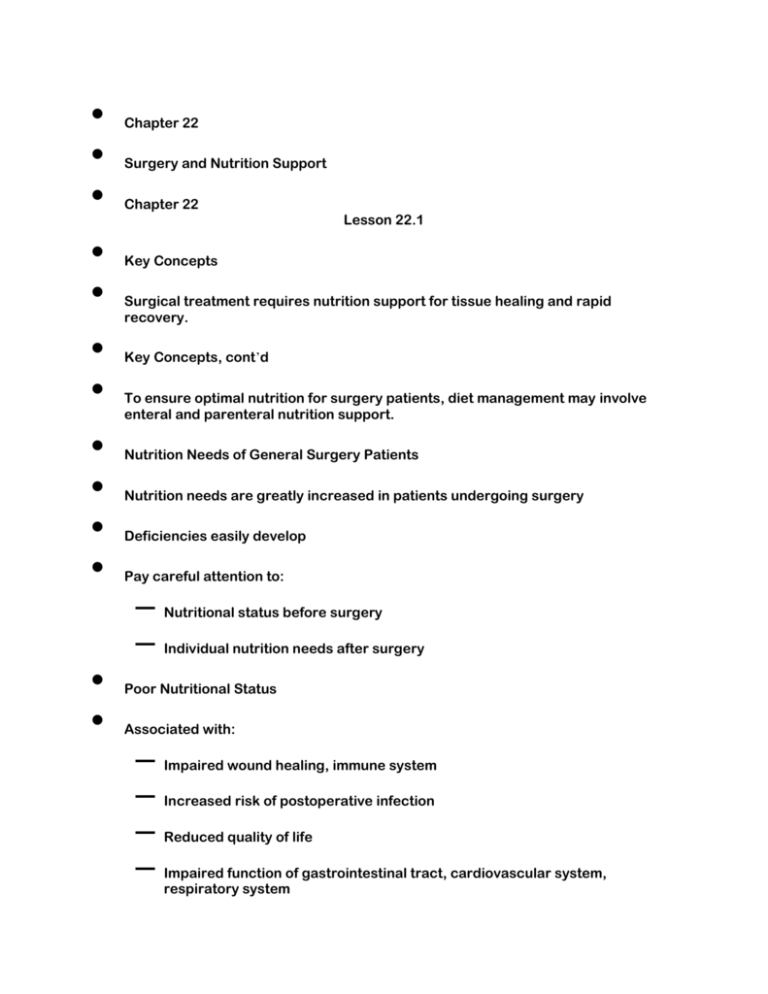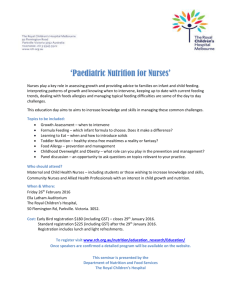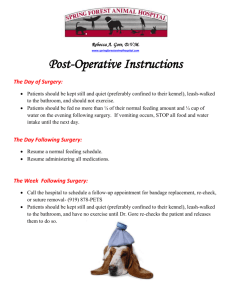Chapter 22 Surgery and Nutrition Support Chapter 22 Lesson 22.1
advertisement

• • • • • • • • • • • • • Chapter 22 Surgery and Nutrition Support Chapter 22 Lesson 22.1 Key Concepts Surgical treatment requires nutrition support for tissue healing and rapid recovery. Key Concepts, cont’d To ensure optimal nutrition for surgery patients, diet management may involve enteral and parenteral nutrition support. Nutrition Needs of General Surgery Patients Nutrition needs are greatly increased in patients undergoing surgery Deficiencies easily develop Pay careful attention to: – – Nutritional status before surgery Individual nutrition needs after surgery Poor Nutritional Status Associated with: – – – – Impaired wound healing, immune system Increased risk of postoperative infection Reduced quality of life Impaired function of gastrointestinal tract, cardiovascular system, respiratory system • • • • • • • • • • • • • • • • – Increased hospital stay, cost, mortality rate Preoperative Nutrition Care: Nutrient Reserves Nutrient reserves can be built up before elective surgery to fortify a patient Protein deficiencies are common Sufficient kilocalories are required – Extra carbohydrates maintain glycogen stores Vitamin and mineral deficiencies should be corrected Water balance should be assessed Immediate Preoperative Period Patients are typically directed not to take anything orally for at least 8 hours before surgery. Before gastrointestinal surgery, a nonresidue diet may be prescribed. Nonresidue elemental formulas provide complete diet in liquid form. Nonresidue Diet Includes only foods free of fiber, seeds, and skins Prohibited foods include fruits, vegetables, cheese, milk, potatoes, unrefined rice, fats, pepper Vitamin and mineral supplements required for prolonged nonresidue diet Postsurgical Nonresidue Diet Nonresidue diet plus: – – Processed cheese, mild cream cheeses Potatoes – – – • • • • • • • • • • • • • • • • • Bread without bran All desserts except those containing fruit and nuts Condiments as desired Postoperative Nutrition Care: Nutrient Needs for Healing Postoperative nutrient losses are great but food intake is diminished. Protein losses occur during surgery from tissue breakdown and blood loss. Catabolism usually occurs after surgery (tissue breakdown and loss exceed tissue buildup). Negative nitrogen balance may occur. Need for Increased Protein Building tissue for wound healing Controlling shock Controlling edema Healing bone Resisting infection Transporting lipids Problems Resulting from Protein Deficiency Poor healing of wounds and fractures Rupture of suture lines (dehiscence) Depressed heart and lung function Anemia, liver damage • • • • • • • • • • • • Failure of gastrointestinal stomas to function Reduced resistance to infection Extensive weight loss Increased mortality risk Other Postoperative Concerns Ensure sufficient fluids to prevent dehydration Provide sufficient nonprotein kilocalories for energy to spare protein for tissue building Ensure adequate vitamins Ensure adequate potassium, phosphorus, iron, zinc Avoid electrolyte imbalances Energy Mifflin–St. Jeor equations: – Male: BMR = 10 × Weight + 6.25 × Height – 5 × Age + 5 – Female: BMR = 10 × Weight + 6.25 × Height – 5 × Age – 161 • • • • • Energy needs for burn patients directly depend on percent of body surface area (BSA) burned and are calculated as follows: Energy needs = 20 kcal/kg + (40 % of BSA burned) Initial Intravenous Fluid and Electrolytes Oral feeding is encouraged soon after surgery. Routine postoperative intravenous fluids supply hydration and electrolytes, not kilocalories and nutrients. Methods of Feeding • • • • • • • • • • • • • • • • • • Enteral: Nourishment through regular gastrointestinal route, either by regular oral feedings or by tube feedings Parenteral: Nourishment through small peripheral veins or large central vein Oral Feeding Allows more needed nutrients to be added Stimulates normal action of the gastrointestinal tract Can usually resume once regular bowel sounds return Progresses from clear to full liquids, then to a soft or regular diet Enteral Feeding Used when oral feeding cannot be tolerated Nasogastric tube is most common route Nasoduodenal or nasojejunal tube more appropriate for patients at risk for aspiration, reflux, or continuous vomiting Enteral Feeding, cont’d Alternate Routes for Enteral Tube Feeding Esophagostomy Percutaneous endoscopic gastrostomy Percutaneous endoscopic jejunostomy Tube-Feeding Formula Generally prescribed by the physician • • • • • • • • • • • • Important to regulate amount and rate of administration Diarrhea is most common complication Wide variety of commercial formulas available Enteral Nutrition Monitoring Monitoring the patient receiving enteral nutrition – – – – – Weight (at least three times per week) Signs and symptoms of edema (daily) Signs and symptoms of dehydration (daily) Fluid intake and output (daily) Adequacy of enteral intake (at least twice per week) Enteral Nutrition Monitoring, cont’d Abdominal distention and discomfort Gastric residuals (every 4 hours) if appropriate Serum electrolytes, blood urea nitrogen, creatinine (two to three times per week) Serum glucose, calcium, magnesium, phosphorus (weekly or as ordered) Stool output and consistency (daily) Sample Calculation* • How much formula (in milliliters) does the following patient need at each feeding? – – – – 37-year-old woman, 5 feet, 7 inches tall Under considerable catabolic stress, with an injury factor of 1.8 Formula: 1.5 kcal/ml Schedule: 6 bolus feedings per day • • IBW: 100 lb + (7 in 5 lb) = 135 lb/2.2 = 61.4 kg • • Formula: 2398 kcal/day 1.5 kcal/ml = 1599 ml/day RMR: (10 61.4 kg) + (6.25 170.2 cm) - (5 37) - 161 = 1332 kcal/day 1332 kcal/day 1.8 = 2398 kcal/day Feeding schedule: 1599 ml/day 6 feedings/day = 266.5 ml/feeding *These equations require the weight in kilograms, the height in centimeters, and the age in years. • • • • • • • • • • Parenteral Feeding Routes Peripheral parenteral nutrition uses less-concentrated solutions through small peripheral veins when feeding is necessary for a brief period (10 days) Total parenteral nutrition used when energy and nutrient requirement is large or to supply full nutrition support for long periods through large central vein Catheter Placement for Parenteral Nutrition Catheter Placement for Parenteral Nutrition, cont’d Catheter Placement for Parenteral Nutrition, cont’d Catheter Placement for Parenteral Nutrition, cont’d Administration of Parenteral Nutrition Careful administration of total parenteral nutrition formulas is essential. Specific protocols vary somewhat but usually include the following points: – – – – – – – Start slowly Schedule carefully Monitor closely Increase volume gradually Make changes cautiously Maintain a constant rate Discontinue slowly Chapter 22 Lesson 22.2 • • • • • • • • • • • • • • • • • • • Key Concepts Nutrition problems related to gastrointestinal surgery require diet modifications because of the surgery’s effect on normal food passage. Key Concepts, cont’d To ensure optimal nutrition for surgery patients, diet management may involve enteral and parenteral nutrition support. Nutrition after Gastrointestinal Surgery Gastrointestinal surgery requires special nutrition attention Nutrition therapy varies depending on the surgery site Mouth, Throat, and Neck Surgery This surgery requires modification in the mode of eating. Patients cannot chew or swallow normally. Oral liquid feedings ensure adequate nutrition. Mechanical soft diet may be optimal. Tube feedings are required for radical neck or facial surgery. Gastric Surgery Because the stomach is the first major food reservoir in the gastrointestinal tract, stomach surgery poses special problems in maintaining adequate nutrition. Problems may develop immediately after surgery or after regular diet resumes. Immediate Postoperative Period Increased gastric fullness and distention may result if gastric resection involved a vagotomy (cutting of the vagus nerve) Weight loss is common • • • • • • • • • • • • • • • • • Patient may be fed by jejunostomy Frequent small, simple oral feedings are resumed according to patient’s tolerance Dumping Syndrome Common complication of extensive gastric resection in which readily soluble carbohydrates rapidly “dump” into small intestine Symptoms include: – – – – Cramping, full feeling Rapid pulse Wave of weakness, cold sweating, dizziness Nausea, vomiting, diarrhea Occurs 30 to 60 minutes after meal Results in patient eating less food Diet for Postoperative Gastric Dumping Syndrome Five or six small meals daily Relatively high fat content, low simple carbohydrate content, low-roughage foods, high protein content No milk, sugar, alcohol, or sweet sodas; no very hot or very cold foods Fluids avoided 1 hour before and after meals; minimal fluids during meals Gallbladder Surgery Cholecystectomy is the removal of the gallbladder. Surgery is minimally invasive. Some moderation in dietary fat is usually indicated after surgery. Depending on individual tolerance and response, a relatively low-fat diet may be needed over a period of time. • • • • • • • • • • • • • • • • Gallbladder with Stone Intestinal Surgery Intestinal resections are required in cases involving tumors, lesions, or obstructions. When most of the small intestine is removed, total parenteral nutrition is used with small allowance of oral feeding. Stoma may be created for elimination of fecal waste (ileostomy, colostomy). Intestinal Surgery, cont’d Intestinal Surgery, cont’d Rectal Surgery Clear fluid or nonresidue diet may be indicated after surgery to reduce painful elimination and allow healing. Return to a regular diet is usually rapid. Nutrition Needs for Burn Patients Tremendous nutritional challenge Plan of care influenced by: – – – Age Health condition Burn severity Plan constantly adjusted Critical attention paid to amino acid needs Type and Extent of Burns • • • • • • • • Stages of Nutrition Care of Burn Patients Stage 1, part 1: Immediate shock period – – – – Immediate loss of water, electrolytes, protein Immediate intravenous fluid therapy with salt solution administered Albumin solutions or plasma used after 12 hours to restore blood volume Little attempt made to meet protein and energy requirements Stages of Nutrition Care of Burn Patients, cont’d Stage 1, part 2: Recovery period – – – Tissue fluids and electrolytes are gradually reabsorbed after 48 to 72 hours. Diuresis indicates successful initial therapy. Constant attention to fluid intake and output remains essential. Stages of Nutrition Care of Burn Patients, cont’d Stage 2, part 1: Secondary feeding period – – – – – – Adequate bowel function returns after 7days. Life depends on rigorous nutrition therapy. Protein and electrolytes lost through tissue destruction must be replaced. Lean body mass and nitrogen are lost through tissue catabolism. Increased metabolism occurs. Increased energy is needed. Stages of Nutrition Care of Burn Patients, cont’d Stage 2, part 2: Nutrition therapy – High protein intake – – • • • • • • • • • Caloric needs based on total BSA burned Liberal portion of kilocalories from carbohydrates Avoid overfeeding High vitamin and mineral intake Stages of Nutrition Care of Burn Patients, cont’d Stage 2, part 3: Dietary management – – • • High energy intake Enteral feeding • • • Solid foods based on individual preferences Concentrated liquids with added protein or amino acids Calculated tube feedings when required Parenteral feeding • When enteral feeding is impossible or inadequate Stages of Nutrition Care of Burn Patients, cont’d Stage 3: Follow-up reconstruction – Continued nutrition support to maintain tissue strength for successful grafting or reconstructive surgery Summary The nutritional demands of surgery begin before a patient reaches the operating table. Before surgery, the task is to correct any existing deficiencies and build nutritional reserves to meet surgical demands. After surgery, the task is to replace losses and support recovery. Summary, cont’d • • • • • • Postsurgical feedings are given in a variety of ways. The oral route is always preferred. However, inability to eat or damage to the intestinal tract may require feeding through a tube or into veins. Special formulas are used for such alternate means of nourishment and are designed to meet specific individual needs. Summary, cont’d For patients undergoing surgery on the gastrointestinal tract, special diets are modified according to the surgical procedure performed. For patients with massive burns, increased nutrition support is necessary in successive stages in response to the burn injury and to the continuing tissue rebuilding requirements.









